A beginner's guide to rock pooling
Penned on the 23rd August 2022

What better way to encounter the UK’s array of mini marine creatures than rock pooling? Clamber over rocky crevices and peer into the glittering pools left behind at low tide and you’ll discover a fascinating world of colourful ocean life. It’s a simple, fun and free activity that children and grown-ups alike will enjoy. And it provides a lovely opportunity to teach younger family members about the ocean and its great variety of wildlife.
We’ve put together a guide for those of you that are new to rock pooling, with some top tips on the equipment you’ll need, when’s best to do it and how to do it safely, without causing harm to yourself or any of the creatures. We’ve also included an insight into the interesting wildlife you might encounter, and a round up of some especially good beaches for rock pooling around the UK to get you inspired.
Wildlife you might encounter

Rock pools are magical little worlds, rich with colour, texture and alien-like creatures. Every rock pool is unique (and even the same one can be different each time you visit) but the most diverse are usually the low-down pools that are closest to the sea, because they stay filled with water for the longest.
On any given day there are certain species that you’re more likely to see - and others which are a little harder to come by! Look deep into the pools, check underneath overhangs and gently lift stones and seaweed, watching out for signs of movement or stand-out colours as you go.
You might spot hermit crabs, velvet swimming crabs, green shore crabs, common starfish, brown shrimps, sea urchins, common blennies, beadlet anemones and snakelocks anemones. Look out for dog whelks, limpets and mussels attached to the surrounding rocks too, often in clusters.
It’s a good idea to take an identification guide, if possible, so you can learn more about each of your finds as you go. Here are a few interesting facts to get you started:
- The common starfish’s average size is 20cm across. They can regenerate missing arms - and they can even become whole again from just one arm and a part of the central body!
- ‘Urchin’ comes from the old English word for hedgehog, which makes sense because Common sea urchins are covered with spines.
- The velvet swimming crab has bright red eyes which gives it its other name: Devil crab! They’re quite a feisty species, snapping with claws if they feel threatened, so make sure you’re careful as you lift rocks.
- Hermit crabs borrow shells left by other animals and as they grow, they search for bigger and bigger empty shells.
Equipment
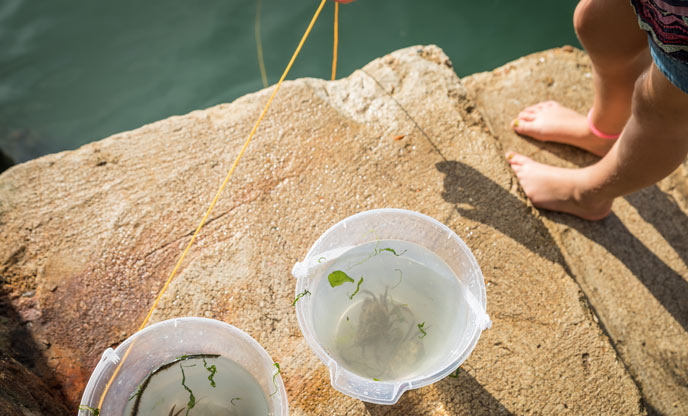
You can explore rock pools without any equipment at all - but to get the best out of it there are a few items that are worth taking along with you.
First of all, a clear bucket or tupperware is perfect for scooping and taking a closer look at your finds. Don’t use a net, as many rock pool creatures are small and delicate and might be harmed if they get tangled. When you submerge your bucket or tupperware, do so slowly, watching out for pinching crab claws and avoiding touching anemones because they can sting!
As mentioned above, take an ID guide if possible (there are lots of books and apps available). And if you have one, a magnifying glass will help you observe your discovery even more closely. A notebook or journal is a fun way to creatively record or sketch your findings too, or if you prefer photography, a camera will do the trick.
Once you’ve marvelled over the creature for a little while be sure to carefully return it to the same spot.
Rocky shores are often very uneven and sharp underfoot so make sure you wear sturdy shoes, wellies or wetsuit boots - flip flops won’t do! It’s sometimes chillier right beside the sea too, so a warm jumper or a coat is also wise.
When to go

Rock pools are full of life all year round but it’s best to choose a calm, dry day. That’s when the rock pool surface is more likely to be still and it’s easier to see what’s below the water. Plus you’ll be able to spend more time outside without getting too cold, of course. Late spring through to early autumn is often best. But be aware that the water is at its coldest in March, so even if it’s sunny outside you’ll need to wrap up warm.
Most importantly, always check the tides. Rock pooling is only possible at low tide so aim to start an hour or two before then. Spring tides are particularly low and expose the best rocky pools, so if possible, that’s a great time to go! Crucially, many rocky shores get cut off as the tide comes in, so don’t get caught out. Check the tides before you go here.
Be mindful
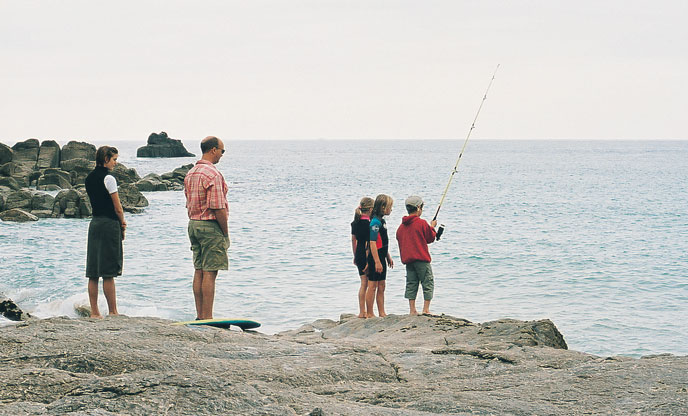
It’s important to remember that you’re entering wild habitats when you’re rock pooling. Respect the creatures’ home and avoid damaging or scaring them by moving slowly and quietly around the pools. You’re more likely to see more wildlife this way too. Be careful not to cast a shadow over the pool either, because the animals will think you’re a predator and hide away.
To keep the wildlife safe and happy, aim to leave all pools exactly as you found them. Carefully replace any stones that you turn over, and again, make sure you return any of the creatures you’ve found to the same spot. Never leave a creature in your bucket or tupperware for too long because the change in water temperature can cause them stress.
It goes without saying but always take your rubbish home. And if you’ve got time, why not be extra kind to the environment and do a quick beach clean along the shore before you leave?
Places to go rock pooling
We’re fortunate enough to have thousands of miles of coastline in the UK, so there are more rock pool hotspots than we can list! Here are a few of our favourite locations across Devon, Cornwall, Pembrokeshire and Dorset.
Wembury, Devon
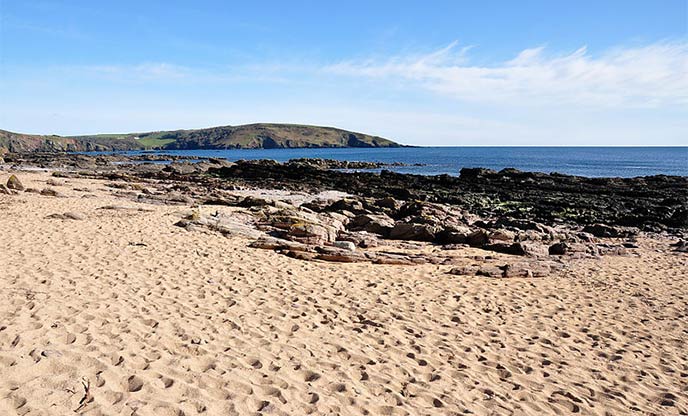
Wembury on the south coast was voted the best rock pool spot in the UK, let alone Devon, by wildlife expert Bill Oddie. And it’s easy to see why. Its pebbly shore, slate reefs and huge rock platforms provide the perfect habitat for lots of marine plants and animals. Devon Wildlife Trust regularly hosts rock pool safaris at this beach, if you fancy exploring with a knowledgeable guide. Check out the upcoming events online before you go.
For more ideas for family days out in Devon, get inspired by our blog post here.
If you’re looking for a place to stay nearby we have lots of beautiful hideaways in this county, from quirky shepherd's huts for two, to spacious yurts for five. Take a look at our full collection of Devon glamping sites here.
Treyarnon Bay, Cornwall
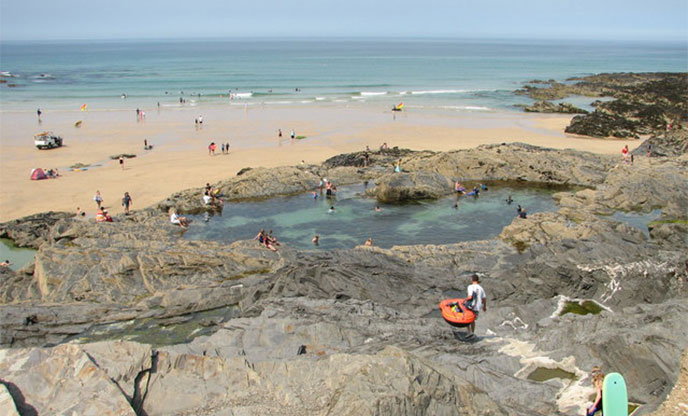
Rock pooling is a common activity in Cornwall because there are plenty of beautiful spots to try it out! But Treyarnon Bay, between Newquay and Padstow on the north coast, is arguably one of the best. This long golden beach has lots of rocky areas that form pools in their nooks and gullies, especially on the north side. When the tide goes out there’s even a 9m long, 2.5m deep natural tidal pool revealed. You can snorkel here if you’ve got the kit, for an alternative view on the marine life below the surface.
Rock pooling isn’t the only activity in which to see and experience this county’s rich variety of wildlife either. Take a look at our guide The best ways to see Cornwall’s wildlife for plenty of inspiration, from boat trips to beaver walks.
You’ll be spoilt for choice when it comes to accommodation here too. Browse our collection of Cornish cabins, houseboats and more here.
Manorbier Beach, Pembrokeshire
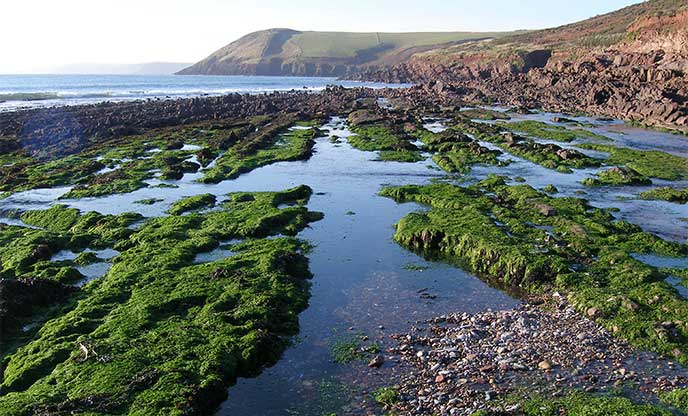
This unspoilt beach has a beautiful setting on the West Wales coast, with sandy dunes and a medieval castle for a backdrop. It’s a popular surf spot - but it’s also excellent for rock pooling at low tide. At either side of the shore you’ll find low sandstone cliffs and scattered rock pools brimming with wildlife and ready to be explored.
Manorbier is not far from the popular resorts of Tenby and Saundersfoot, but it’s a lesser-known and often quieter spot for a beach day. Take a look at our guide to The best beaches in Pembrokeshire for other beautiful stretches of sand and sea in this area.
Pembrokeshire has plenty more to see and do too, so you might like to stay for a week or more. Take a look at our romantic retreats and family-friendly hideaways here.
Kimmeridge Bay, Dorset

If you fancy tying in rock pooling with fossil hunting, this is the perfect spot! Kimmeridge Bay on the Jurassic Coast is famous for both. The Dorset Wildlife Trust Fine Foundation Marine Centre is open at Kimmeridge Bay from April to October too, with informative interactive displays, fascinating aquaria and rock pool ramble events.
Find out more about this area, the UK’s only UNESCO site, and what it has to offer with our Guide to the Jurassic Coast.
And if you’re planning on staying for a while, take a look at our collection of unique coastal and countryside glamping sites in Dorset here.